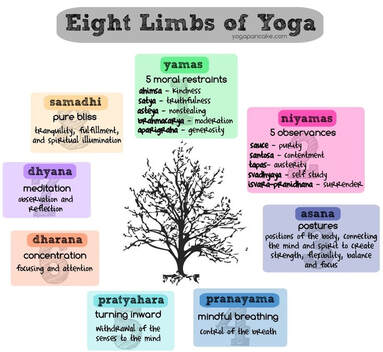 Whilst we’re all pretty familiar with the physical practice of yoga these days, there is more to it than simple asana practice as a form of exercise. Circa 300 BC, Patanjali, the sage and wisest of yogis, who was the first person really to codify Yoga via his sutras, set out to systematically set down on paper (or whatever was in use back then!) the whole of yoga teaching. His much quoted phrase “Chitta Vrtti Nirodha” roughly translated means “Yoga Stills The Mind” and that sort of sums it up, but in understanding how that stillness comes about and what it means in truth, we need to understand more of what “Yoga” really entails, and here Patanjali and his categorization of Yoga into eight limbs or “Ashtanga Yoga” (ashtanga is sanskrit for eight limbs) provides the insight we need. Ashtanga Yoga is often confused with Ashtanga Vinyasa Yoga, which is an athletic form of asana practice cultivated by Pattabhi Jois in Mysore which follows a fixed sequence (Primary Series) and has been made famous by many celebs. It’s a really beautiful practice, check out Laruga Glaser’s videos online if you want to be mesmerised by grace, strength and elegance embodied, but it is not quite the same thing as Patanjali’s Eight Limbs, of which asana is one, but which tend to emphasise the mental and moral aspects of Yoga over the purely physical practice. So what are these eight limbs already! Here we go (and bear with me, do remember this is a beautiful if challenging moral ideal, not a stick with which to beat anyone, or a covert criticism of those that find it unappealing…..): Yama – the five moral restraints
Niyama – the five individual observances
Asanas – postures Pranayama – control of vital energy through the breath Pratyahara – withdrawal of the senses to self – going within Dhyana – meditation Samadhi – bliss, super conscious state The eight limbs can be taken individually or worked together - this I believe is one reason for the vast diversity of yoga practiced today. Some of us are purely focusing on asana, others mediation and others the more devotional aspects. Some of us are incorporating aspects of all eight limbs into our daily lives without even knowing it, others more consciously, others not at all. One thing that strikes me more and more is the overlap with so many of today’s secular mindfulness practices and concepts: meditation, being kind, compassion for others, having curiosity and seeking out learning, mindful movement, finding joy and so on. In this modern world many are averse to any hint of spiritual mongering or religiosity – and I can totally understand why, with so many wannabe gurus around seeking fame, ego-inflation and more often than not enrichment, I feel the same way myself a lot of the time – but at the time these concepts were set out faith in a deity was the norm. I'm convinced we can reframe this teaching and secularise the process of becoming connect to self and consciousness. There is no need to disregard the essence of yoga for the sake of (justified) aversion to dogma - that's just throwing out the baby with the bath water. There's also no need to be intimidated by it. I sometimes imagine that the sense of intimidation so many feel coming to a yoga practice is a subconscious instinct that this is something really potentially life changing, which floats up to the level of our consciousness, manifesting as a strange, small fear or anxiety, and is really nothing to be worried about at all. Yoga is at its heart a spiritual practice – cultivating a path to Samadhi and oneness with the divine. What I firmly believe is how you chose to conceive of the divine is up to you. Yoga embraces all. Namaste 🙏🏼❤️🕉
5 Comments
|
Archives
July 2022
Categories |






